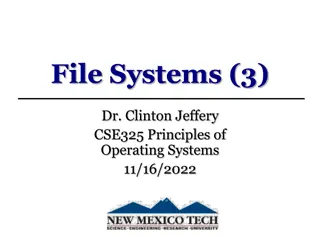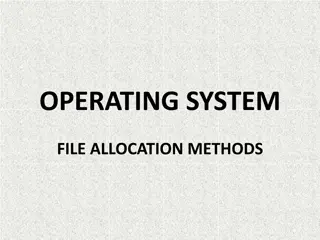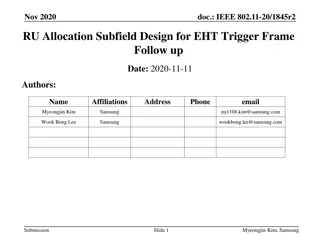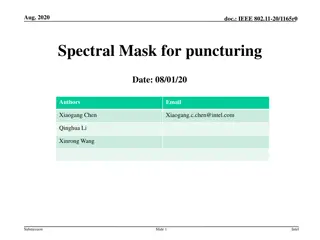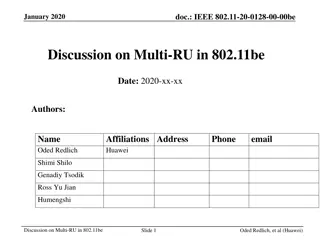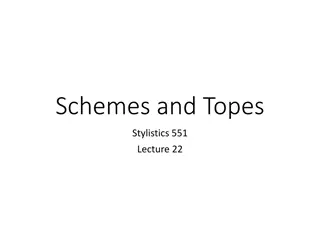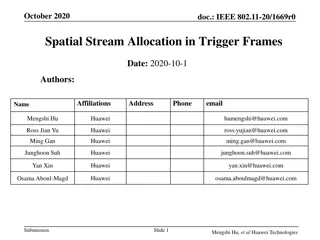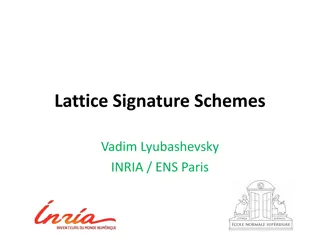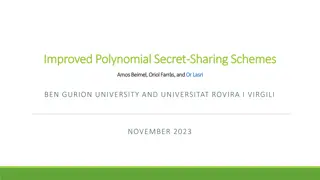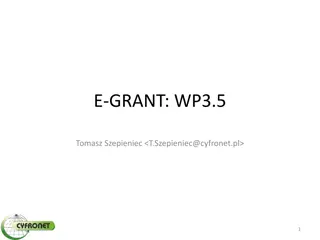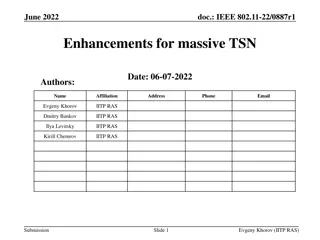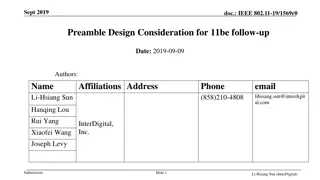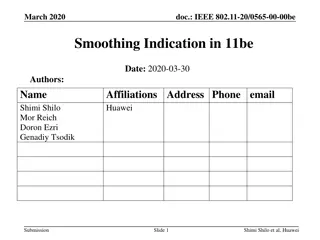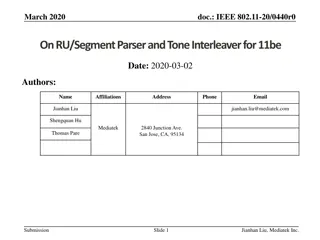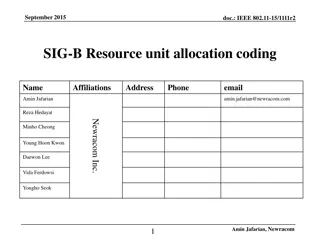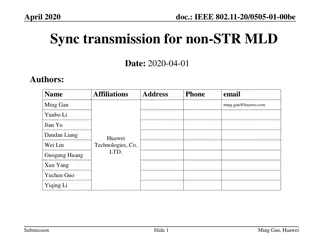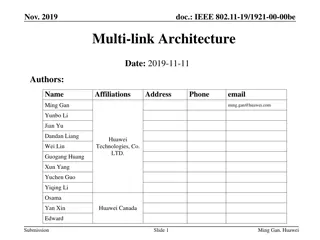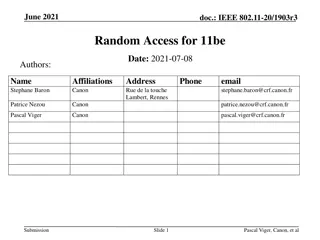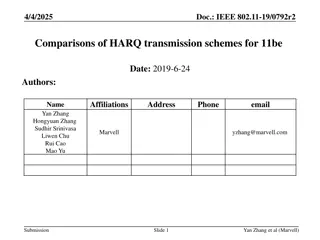
Enhanced Resource Allocation Schemes for IEEE 802.11be Network Efficiency
Explore how the proposed enhanced resource allocation schemes for IEEE 802.11be improve network throughput by allowing multiple contiguous and non-contiguous Resource Units (RUs) assigned to a single station. This remedy addresses the limitations that hinder spectral efficiency in scenarios with fewer users, enhancing overall network performance and efficiency.
Download Presentation

Please find below an Image/Link to download the presentation.
The content on the website is provided AS IS for your information and personal use only. It may not be sold, licensed, or shared on other websites without obtaining consent from the author. If you encounter any issues during the download, it is possible that the publisher has removed the file from their server.
You are allowed to download the files provided on this website for personal or commercial use, subject to the condition that they are used lawfully. All files are the property of their respective owners.
The content on the website is provided AS IS for your information and personal use only. It may not be sold, licensed, or shared on other websites without obtaining consent from the author.
E N D
Presentation Transcript
July 2019 doc.: IEEE 802.11-19/1126r1 Enhanced Resource Allocation Schemes for 11be Date: 2019-06-12 Authors: Name Affiliations Address Phone Email Jianhan Liu jianhan.liu@mediatek.com Mediatek Yongho Seok Submission Slide 1 Jianhan Liu, Mediatek Inc.
July 2019 doc.: IEEE 802.11-19/1126r1 Outline In the HE WLAN based on IEEE 802.11ax standard, each non-AP station (STA) can only be assigned with a single resource unit (RU). We show that such restrictions on RU allocations significantly reduce the spectral efficiency and the network throughput in some scenarios. We propose the enhanced RU allocation schemes for 11be that allows multiple contiguous and non-contiguous RUs assigned to a single STA. Submission Slide 2 Jianhan Liu, Mediatek Inc.
July 2019 doc.: IEEE 802.11-19/1126r1 One RU per User Degrades Spectral Efficiency This constraint degrades the spectral efficiency when number of users are small. For example, when a 20MHz channel is assigned to two users, according to current 11ax spec., the center 26tone-RU must be wasted. (more than 10% spectral efficiency loss). Not Used 106 106 26 For Example, two users in 80MHz transmission, if one user is allocated to 242-tone RU, then the other user can only use 484-tone RU. There are 242-Tone RU and a 26-tone RU are wasted (more than 25% spectral efficiency loss). Not Used 484 242 242 26 Submission Slide 3 Jianhan Liu, Mediatek Inc.
July 2019 doc.: IEEE 802.11-19/1126r1 One RU per User Wastes BW in preamble Puncture For preamble puncture cases due to radar signals (for DFS channels), if the transmission is to a single user, then only primary 20MHz can be used if radar signals is detected in the secondary 20MHz channel. In this case, if the BSS bandwidth is 80MHz, then 40MHz BW are wasted, which is 200% spectral efficiency degradation. In this case, if the BSS bandwidth is 160MHz, then 140MHz BW are wasted, which is 700% spectral efficiency degradation. Punctured sub-channel Can be used for normal transmssion Frequency segments need spectial care P20 S20 26-tone 1 2 3 4 6 7 8 9 10 11 12 13 15 16 17 18 20 21 22 23 25 26 27 28 29 30 31 32 34 35 36 37 1 2 5 3 4 5 6 14 7 8 9 10 24 11 12 13 14 33 15 16 52-tone 1 2 3 4 19 5 6 7 8 106-tone 1 2 3 4 242-tone 1 2 484-tone 996-tone 1 Submission Slide 4 Jianhan Liu, Mediatek Inc.
July 2019 doc.: IEEE 802.11-19/1126r1 One RU per User Also Hurts the Diversity Gain For example, in a 80MHz MU transmissions, the channel profile of user 1 is as shown in figure 3, it is better to allocate the RUs located on [0:20] MHz and [60:80] MHz. Therefore the frequency diversity cannot be fully exploited in such transmissions. 10 9 8 7 Channel profile (dB) 6 5 4 3 2 1 0 10 20 30 40 50 60 70 80 Frequency (MHz) Submission Slide 5 Jianhan Liu, Mediatek Inc.
July 2019 doc.: IEEE 802.11-19/1126r1 LTE allows multiple RBs allocated to one User Resource Block (RB) in LTE is similar to RU in IEEE 802.11 for WLAN. LTE allows multiple RBs (contiguous and non-contiguous) allocated to one user. To enhance the WLAN performance to be comparable to cellular systems, WLAN needs to have enhanced RU allocation schemes that allow multiple RUs to be allocated to one user Submission Slide 6 Jianhan Liu, Mediatek Inc.
July 2019 doc.: IEEE 802.11-19/1126r1 Straw Poll #1 Do you support to allow more than one Resource Units (RUs) to be assigned to a single STA in 11be? Coding and interleaving schemes for multiple RUs assigned to a single STA are TBD. Maximum number of RUs (>1) assigned to a single STA is also TBD. Submission Slide 7 Jianhan Liu, Mediatek Inc.
July 2019 doc.: IEEE 802.11-19/1126r1 Motion #1 Move to add the following text into 11be SFD: 11be shall allow more than one Resource Units (RUs) to be assigned to a single STA Coding and interleaving schemes for multiple RUs assigned to a single STA are TBD. Maximum number of RUs (>1) assigned to a single STA is also TBD. Submission Slide 8 Jianhan Liu, Mediatek Inc.

